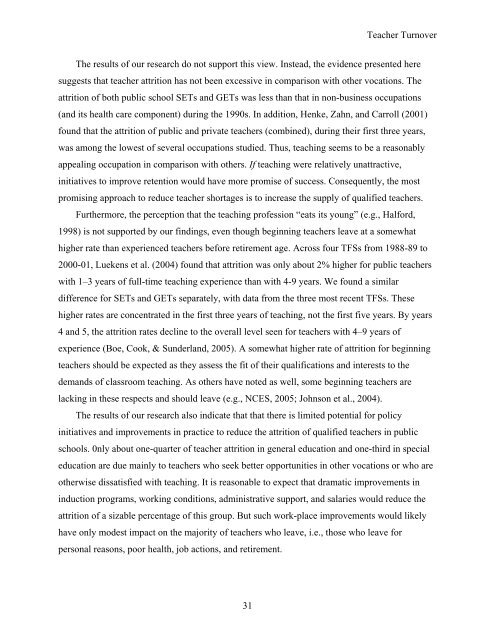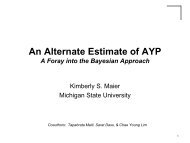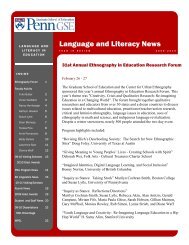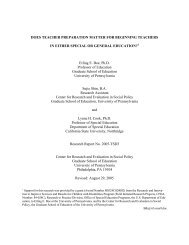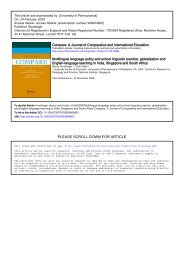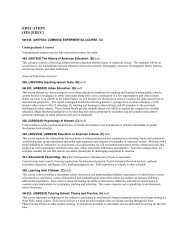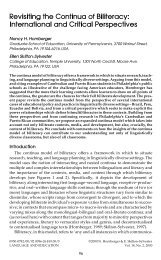Teacher turnover in special and general education: attrition
Teacher turnover in special and general education: attrition
Teacher turnover in special and general education: attrition
Create successful ePaper yourself
Turn your PDF publications into a flip-book with our unique Google optimized e-Paper software.
<strong>Teacher</strong> Turnover<br />
The results of our research do not support this view. Instead, the evidence presented here<br />
suggests that teacher <strong>attrition</strong> has not been excessive <strong>in</strong> comparison with other vocations. The<br />
<strong>attrition</strong> of both public school SETs <strong>and</strong> GETs was less than that <strong>in</strong> non-bus<strong>in</strong>ess occupations<br />
(<strong>and</strong> its health care component) dur<strong>in</strong>g the 1990s. In addition, Henke, Zahn, <strong>and</strong> Carroll (2001)<br />
found that the <strong>attrition</strong> of public <strong>and</strong> private teachers (comb<strong>in</strong>ed), dur<strong>in</strong>g their first three years,<br />
was among the lowest of several occupations studied. Thus, teach<strong>in</strong>g seems to be a reasonably<br />
appeal<strong>in</strong>g occupation <strong>in</strong> comparison with others. If teach<strong>in</strong>g were relatively unattractive,<br />
<strong>in</strong>itiatives to improve retention would have more promise of success. Consequently, the most<br />
promis<strong>in</strong>g approach to reduce teacher shortages is to <strong>in</strong>crease the supply of qualified teachers.<br />
Furthermore, the perception that the teach<strong>in</strong>g profession “eats its young” (e.g., Halford,<br />
1998) is not supported by our f<strong>in</strong>d<strong>in</strong>gs, even though beg<strong>in</strong>n<strong>in</strong>g teachers leave at a somewhat<br />
higher rate than experienced teachers before retirement age. Across four TFSs from 1988-89 to<br />
2000-01, Luekens et al. (2004) found that <strong>attrition</strong> was only about 2% higher for public teachers<br />
with 1–3 years of full-time teach<strong>in</strong>g experience than with 4-9 years. We found a similar<br />
difference for SETs <strong>and</strong> GETs separately, with data from the three most recent TFSs. These<br />
higher rates are concentrated <strong>in</strong> the first three years of teach<strong>in</strong>g, not the first five years. By years<br />
4 <strong>and</strong> 5, the <strong>attrition</strong> rates decl<strong>in</strong>e to the overall level seen for teachers with 4–9 years of<br />
experience (Boe, Cook, & Sunderl<strong>and</strong>, 2005). A somewhat higher rate of <strong>attrition</strong> for beg<strong>in</strong>n<strong>in</strong>g<br />
teachers should be expected as they assess the fit of their qualifications <strong>and</strong> <strong>in</strong>terests to the<br />
dem<strong>and</strong>s of classroom teach<strong>in</strong>g. As others have noted as well, some beg<strong>in</strong>n<strong>in</strong>g teachers are<br />
lack<strong>in</strong>g <strong>in</strong> these respects <strong>and</strong> should leave (e.g., NCES, 2005; Johnson et al., 2004).<br />
The results of our research also <strong>in</strong>dicate that that there is limited potential for policy<br />
<strong>in</strong>itiatives <strong>and</strong> improvements <strong>in</strong> practice to reduce the <strong>attrition</strong> of qualified teachers <strong>in</strong> public<br />
schools. 0nly about one-quarter of teacher <strong>attrition</strong> <strong>in</strong> <strong>general</strong> <strong>education</strong> <strong>and</strong> one-third <strong>in</strong> <strong>special</strong><br />
<strong>education</strong> are due ma<strong>in</strong>ly to teachers who seek better opportunities <strong>in</strong> other vocations or who are<br />
otherwise dissatisfied with teach<strong>in</strong>g. It is reasonable to expect that dramatic improvements <strong>in</strong><br />
<strong>in</strong>duction programs, work<strong>in</strong>g conditions, adm<strong>in</strong>istrative support, <strong>and</strong> salaries would reduce the<br />
<strong>attrition</strong> of a sizable percentage of this group. But such work-place improvements would likely<br />
have only modest impact on the majority of teachers who leave, i.e., those who leave for<br />
personal reasons, poor health, job actions, <strong>and</strong> retirement.<br />
31


